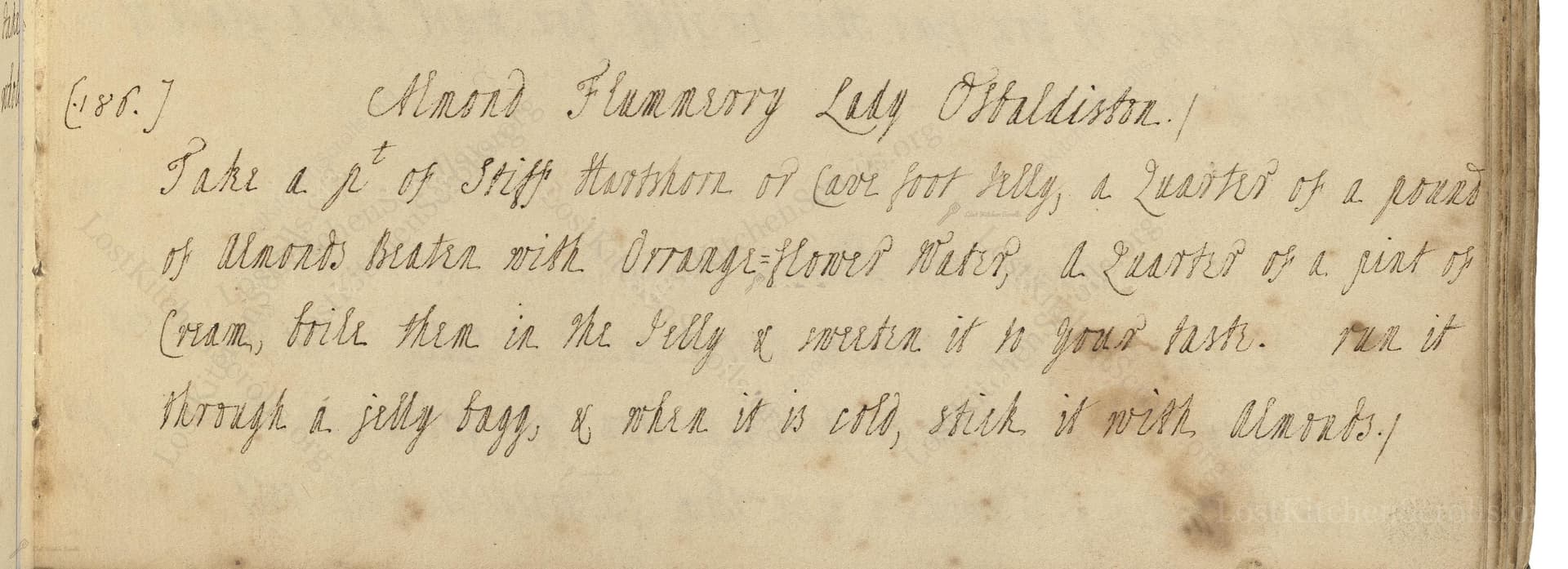Almond Flummerrey Lady Osbaldiston
From the treasured pages of Cookery and medicinal recipes of Dorothy Pennyman
Written by Dorothy Pennyman

Almond Flummerrey Lady Osbaldiston
"Take a pt of Stiff Hartshorn or Cave foot Jelly, a Quarter of a pound of Almonds beaten with Orrange-flower water, a Quarter of a pint of Cream, boile them in the Jelly & sweeten it to your taste. run it through a jelly bagg, & when it is cold, stick it with Almonds."
Note on the Original Text
The recipe was written in the concise, matter-of-fact style typical of 18th-century manuscripts, assuming the cook's familiarity with basic preparations (like making hartshorn or calves' foot jelly). Words like 'beaten' refer to grinding, and no strict quantities for sweetening are given, reflecting reliance on personal taste and experience. Spelling reflects period conventions ('boile,' 'bagg') and the lack of standardization in recipe writing. The focus is on sequencing—boil, strain, decorate—capturing the rhythm of kitchen work at the time.

Title
Cookery and medicinal recipes of Dorothy Pennyman (1730)
You can also click the book image above to peruse the original tome
Writer
Dorothy Pennyman
Era
1730
Publisher
Unknown
Background
A delightful glimpse into early Georgian kitchens, this culinary manuscript compiled by Dorothy Pennyman showcases the elegant tastes and recipes of 18th-century England—perfect for those hungry for a taste of history.
Kindly made available by
Folger Shakespeare Library
This recipe for Almond Flummery comes from the early 18th century, sourced from the recipe collection of Dorothy Pennyman, Lady Osbaldiston, compiled circa 1730. At the time, flummery was a fashionable dish at elegant English tables, bridging the worlds of jelly and custard desserts. Its ingredients—especially almonds and orange-flower water—evoked both opulence and a nod to continental flavors, reflecting increasing global trade. The method also showcases the culinary technology of the day, when elaborate jellies were a sign of both culinary skill and access to costly ingredients.

Back then, the cook would have used a sturdy saucepan over an open fire or range to heat and dissolve the jelly. Almonds would be painstakingly ground in a mortar and pestle, and the mixture strained through a lined jelly bag crafted from fine muslin or flannel to ensure a clear, smooth dessert. Presentation was also key—special moulds or shallow dishes allowed for elegant unmoulding and decorative almond garnish.
Prep Time
15 mins
Cook Time
5 mins
Servings
6
We've done our best to adapt this historical recipe for modern kitchens, but some details may still need refinement. We warmly welcome feedback from fellow cooks and culinary historians — your insights support the entire community!
Ingredients
- 2 cups prepared jelly (use 2 cups water + 1.5-2 tbsp powdered gelatin or commercial stock gelatin, or calves' foot jelly as a traditional alternative)
- 4 oz blanched almonds
- 2 tsp orange-flower water (substitute with orange extract if unavailable)
- 1/2 cup double cream
- 1/4 cup granulated sugar (adjust to taste)
- Whole or slivered almonds (for decoration)
Instructions
- To recreate Lady Osbaldiston's Almond Flummery in the modern kitchen, begin by preparing a clear, stiff gelatine jelly using about 2 cups of water and enough powdered gelatin (around 1.5-2 tbsp) to set it firmly.
- Alternatively, if you're feeling historically adventurous, use calves' foot jelly if available!
- In a food processor, finely grind 4 oz of blanched almonds with a few teaspoons (about 2 tsp) of orange-flower water to form a fragrant almond paste.
- In a saucepan, gently heat the prepared jelly together with the almond paste and 1/2 cup of double cream, stiring until everything is smoothly combined and fragrent.
- Sweeten the mixture with sugar to your taste (start with about 1/4 cup and adjust as you like).
- Strain the mixture through a fine sieve or muslin-lined sieve into a mould or serving dish to achieve a silky-smooth finish.
- Allow the flummery to cool and set in the refrigerator.
- Once firm, cut into slices or unmould, and decorate the surface by studding with whole or slivered almonds.
Estimated Calories
230 per serving
Cooking Estimates
Preparing Lady Osbaldiston's Almond Flummery takes some time for mixing and chilling. You'll spend about 20 minutes on preparation and stovetop mixing, then the flummery needs at least 4 hours in the fridge to set. The nutrition estimate is based on dividing the dessert into 6 servings.
As noted above, we have made our best effort to translate and adapt this historical recipe for modern kitchens, taking into account ingredients nowadays, cooking techniques, measurements, and so on. However, historical recipes often contain assumptions that require interpretation.
We'd love for anyone to help improve these adaptations. Community contributions are highly welcome. If you have suggestions, corrections, or cooking tips based on your experience with this recipe, please share them below.
Join the Discussion
Rate This Recipe
Dietary Preference
Culinary Technique

Den Bockfisch In Einer Fleisch Suppen Zu Kochen
This recipe hails from a German manuscript cookbook compiled in 1696, a time whe...

Die Grieß Nudlen Zumachen
This recipe comes from a rather mysterious manuscript cookbook, penned anonymous...

Ein Boudain
This recipe comes from an anonymous German-language manuscript cookbook from 169...

Ein Gesaltzen Citroni
This recipe, dating from 1696, comes from an extensive anonymous German cookbook...
Browse our complete collection of time-honored recipes



